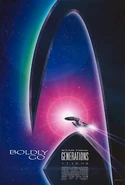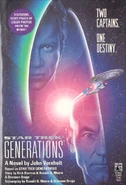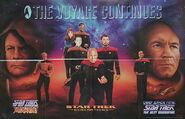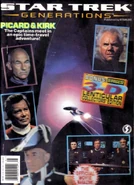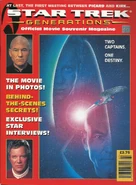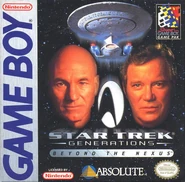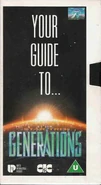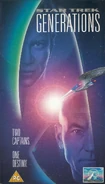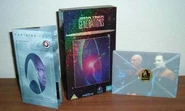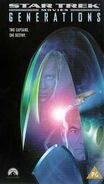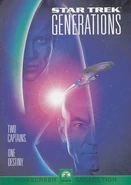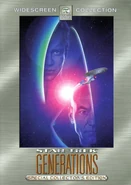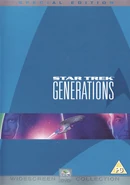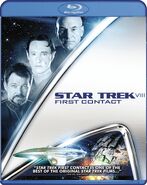Template:Realworld "Two captains. One destiny."
An old mad scientist, the El-Aurian Dr. Tolian Soran, is seeking eternal happiness for himself, and wreaking interstellar catastrophe in the process. Captain Jean-Luc Picard of the Starship Enterprise-D must stop him, regardless of the sacrifices that are necessary. But, he finds an unexpected ally from the past as the same objective that drives Soran's madness also bridges two generations of Federation captains, uniting them for a singular cause.
Summary
Prologue
23rd century (2293)

The launch of the Enterprise-B
A bottle of Dom Pérignon cracks against the hull of the new USS Enterprise at the starship's christening. On the drydock facility, people applaud the christening. On the Enterprise bridge, three guests of honor, James T. Kirk, Montgomery Scott, and Pavel Chekov, emerge from the turbolift and are immediately surrounded by reporters. Their frantic questioning is interrupted by Enterprise Captain John Harriman who says there'll be time for that later and welcomes the new arrivals to the bridge. He then tells Kirk how he's pleased to have a group of living legends aboard and how he read about their exploits when he was in grade school. After a rather awkward moment, Kirk asks if they can look around and Harriman obliges. Kirk is asked by a reporter about how he feels for the first starship Enterprise in thirty years to be launching without him in command. Kirk says he's fine with it and happy to be able to send the Enterprise on her way. Before he can be grilled further, an Enterprise crewman asks the reporter to let Kirk look around first. Chekov then calls Kirk over and introduces him to the Enterprise's helm officer, Ensign Demora Sulu. Demora tells Kirk that her father has told her some stories about him, which surprises Kirk that Hikaru Sulu is her father. Chekov reminds Kirk that he's met her before which Kirk remembers, but didn't think it to be that long ago. Chekov tells Kirk it was twelve years previous. Kirk shakes Demora's hand and tells her, "It wouldn't be the Enterprise without a Sulu at the helm." Demora returns to the helm and Chekov marvels at her, remarking to Kirk that he was never that young. Kirk agrees, but tells Chekov that he was younger. Scotty walks by and remarks that the Enterprise is a "damn fine ship." Kirk tells Scotty he's amazed that Sulu found time to have a family. Scotty says that just as Kirk would say, "'If something's important, you make the time.'" He then wonders if that might be what Kirk's problem is and that he might be finding retirement a bit lonely. Kirk remarks that he's glad Scotty is an engineer because with tact like that, he'd be a lousy psychiatrist. Just then, Harriman steps up and tells Kirk and Scotty it's time to go and would they please take their seats. Kirk and Scotty move away from the captain's chair and Harriman starts to order the ship out of dock, but then he turns and asks Kirk to give the order to get them underway. At first Kirk begs off, but Harriman keeps asking. Kirk tries to get out of it, but Harriman insists and with the reporters all there, Kirk finally stands and orders the helm to take them out. After everyone on the bridge applauds, the Enterprise leaves drydock on its maiden voyage around Earth's solar system.
As the Enterprise-B cruises out of drydock and into open space, a distress call comes in over the com. At first hesitant, Captain Harriman orders the Enterprise into action. Kirk nervously shifts around in his chair. Scotty notices this and asks if there is something wrong with his chair, implying that he knows of Kirk wanting to take over the situation. Not far out, they encounter two El-Aurian refugee ships, the SS Lakul and the SS Robert Fox, caught in a strange energy ribbon.

Three legends reunite
Faced with gravimetric distortions that threaten to destroy his ship, Harriman – at the urging of Captain Kirk – resolves to take the Enterprise into the ribbon. As they enter, the Robert Fox explodes, killing all 265 on-board. Attempts at beaming the El-Aurians off the Lakul are thwarted as their life signs phase in and out of the space-time continuum. Scotty begins a transport from the Lakul as it, too, explodes. He manages to save 47 – out of 150. Shortly afterward, the Enterprise itself gets trapped by the energy ribbon.
In sickbay, Chekov works to help wounded refugees as the ship is rocked by the gravimetric distortions. A distraught, middle aged man is particularly violent in his desire to return, and has to be sedated. Also among the refugees is Guinan. On the bridge, Kirk, Scotty and the Enterprise-B crew work to free the ship to no avail. Scotty determines that a photon torpedo blast would free the ship, but with none aboard, the crew must use the navigational deflector to simulate the effect. Initially Harriman volunteers to go to Main Engineering to make the necessary modifications, and asks Kirk to take command, but after Kirk savors the moment of sitting in the Captain's chair one last time, he realizes it's not his place and tells Harriman that he will go instead.
In the bowels of the new Enterprise, Captain Kirk charges to the rescue, climbing into the guts of the ship to modify the main deflector. The ship shakes under the stresses of the ribbon. When Kirk finishes the modifications, Harriman orders the deflector activated, creating a resonance burst that pushes the Enterprise free. As the ship moves away, an arch of energy lashes out, opening a gash along the hull. When they get free, they find out in the damage report that the hull breach was in Main Engineering. Failing to contact Kirk by communication, Harriman and Scotty rush to the scene.
When they get there, joined by Chekov, they find mangled technology and empty space, and no sign of Captain James T. Kirk. Chekov incredulously asks if anyone was in here, and all Scotty can muster is a grim sounding "Aye". Scotty, Chekov and Harriman stare somberly into the open space. The non-cannon Star Trek: Of Gods and Men is set 12 years after this event.
Act One
24th century (2371)
Picard and Riker honor Worf
78 years later, Captain Jean-Luc Picard, Commander William T. Riker and the rest of the crew of the USS Enterprise-D have gathered on the ship's holodeck. Acting as the crew of a 19th century sailing ship, the Starfleet officers celebrate the promotion of Lieutenant Worf to Lieutenant Commander. As a rite of passage, Worf is made to jump on the plank and retrieve his hat, and is purposefully sent into the water when Riker orders the computer to remove the plank; a joke that the android Data admits he does not understand. Savoring the simpler times the holographic ship represents, Captain Picard receives a personal message from Earth on the holodeck arch. While reading the communiqué, Picard expressions changes to one of obvious distress, which Deanna Troi picks up on. Picard looks out to sea in silence, and when Troi asks if everything is all right, he just replies that he's fine and abruptly leaves the celebration. Just after he's gone, a call comes in from the bridge: the Amargosa observatory is under attack.

The Enterprise-D arrives at Amargosa
Arriving at the observatory orbiting the Amargosa star, Picard and company take their positions on the bridge still dressed in formal naval uniforms. Finding the station suffering severe damage and severe casualties, a still visibly upset Picard orders Riker and an away team to search for survivors and retreats to his ready room after snapping at Riker to "just do it" when his first officer tries to get more specific orders. Beaming to the devastated Federation installation, Riker, Worf and Doctor Beverly Crusher find an El-Aurian scientist, Dr. Tolian Soran, injured among the wreckage. Elsewhere, Worf locates the remains of one of the station's attackers: a Romulan.
In his quarters, Data and Chief Engineer Geordi La Forge are hard at work, despite frequent interruptions by the android's cat, Spot. Data ponders his difficulty with humor and other Human emotions and comes to the conclusion that he cannot continue to grow without the aid of Dr. Soong's emotion chip. Despite the risks it poses to his positronic brain, Data urges La Forge to install the chip. La Forge reluctantly agrees. Meeting with Picard in his ready room, Riker reports that they found no motive for the Romulan attack, but a recovered tricorder may yield answers. Riker also reports that Dr. Soran urgently wishes to meet with the captain. Picard complies, but coldly rebuffs Riker when inquired as to what is wrong.

Picard meets Dr. Soran
Later in Ten Forward, Data is all smiles with his new emotion chip activated. He and La Forge approach Guinan at the bar and sample something new from Forcas III. Immediately, Data experiences an emotional reaction: he hates it! As the two officers sample more of the revolting beverage, Captain Picard enters and finds Dr. Soran among the crowd. Soran implores the captain to let him return to the observatory to continue a critical experiment – time is running out. However, Picard is clearly not in the mood for an argument and tells him bluntly that he can only return once his officers have finished their investigation. However Soran tells Picard that "time is the fire in which we burn and right now, my time is running out. We leave so many things unfinished in our lives... I'm sure you understand." Disturbed by the eerie scientist, Picard agrees to see what he can do. After Picard leaves Soran checks his watch and starts to look around, and is shocked when he spots Guinan behind the bar and makes a quick exit. As he leaves, Guinan senses that something isn't right, but Soran is gone by the time she looks around. In engineering, Commander Riker checks on the status of the analysis of the retrieved Romulan tricorder. Worf reports that the Romulans were searching for a compound called trilithium, a substance capable of destroying a star. Riker doesn't understand why the Romulans would ransack a Federation facility for it, but orders the observatory searched.
On the station, Data and La Forge use tricorders to search for trilithium. As they perform their scans, Data laughs incessantly and tells stupid jokes, but despite the distraction, La Forge finds a hidden doorway that the android is able to open. Behind the door is a secret lab, filled with solar probes that show signs of trilithium. Data is doing nothing but laughing now and when an annoyed La Forge finally asks him to knock it off, Data says, while laughing, that he can't help it and something must be wrong and starts reeling in pain, before collapsing as his neural net has been overloaded by the emotion chip. Unable to contact help through a dampening field protecting the lab, La Forge is confronted by Soran, who knocks the engineer out and turns a disruptor on Data, who is filled with fear and begs him not to shoot.

Troi and Picard mourn the dead
In the captain's quarters, Picard sits with his family photo album. Counselor Troi enters and he begins to tell her about his brother and nephew and his plans to get together with them on Earth the following month so he could show Rene Starfleet Academy. As he affectionately describes his nephew he breaks down and tells Troi that both Robert and Rene have burnt to death in a fire. Troi comforts him and Picard tells her that when he was growing up, he was always told about the Picard family line and his famous ancestors. When Robert got married and had a son he no longer felt the responsibility to carry on the family line and as he has got older and felt time creeping up on him he took comfort in the fact that his family would go on. But now it won't and once Jean-Luc is gone, there will be no more Picards. The somber mood is interrupted when suddenly the Amargosa star flashes brightly. Arriving on the bridge, Picard and Troi learn that the observatory has launched a trilithium probe in the sun. The star has collapsed, all fusion reactions arrested, creating a shock wave that will destroy the system. With the away team still on the station, Picard orders Riker and Worf to retrieve Data and La Forge.
On the observatory, Riker and Worf find Data and La Forge held hostage by Soran who responds to the appearance of the Enterprise officers with disruptor fire. Suddenly, a route to La Forge opens and Riker asks Data if he can get to the engineer, but the android is clearly paralyzed by fear and tells him he can't. Entering coordinates into a computer, Soran disappears in the transporter effect with La Forge... transporting aboard a Klingon Bird-of-Prey, de-cloaking near the observatory and warping away. As the away team returns to the ship with Data, Picard orders the Enterprise to warp as the shock wave obliterates the Amargosa observatory.
Act Two
Guinan describes the "Nexus": "Like being inside joy."
On the bridge of the Klingon getaway ship, the Duras sisters, Lursa and B'Etor, are eager to get their hands on Soran's "weapon of unlimited power." The El-Aurian demands they set course for a planet in the Veridian system and the sisters grudgingly comply. In the bowels of the ship, Soran holds La Forge captive. Marveling at the engineer's VISOR, Soran interrogates La Forge to learn all he knows about trilithium. Back on the Enterprise, Dr. Crusher has done some research into Soran's background, telling Commander Riker that he was one of the survivors rescued by the Enterprise-B eighty years ago after the Borg destroyed their world and that Guinan was also on the passenger manifest. To learn more about the scientist, Captain Picard visits Guinan in her quarters. There she describes the energy ribbon as the "Nexus", a blissful realm where time has no meaning, and a place Soran must be trying to get back to. The experience left such an impact on Guinan that she suspects it has turned Soran into a dangerous threat. As he is trying to get back to the Nexus, this raises the question: Why destroy a star?

Picard and Data track the path of the Nexus
- "Captain's log, stardate 48632.4. Dr. Crusher has informed me that Data's emotion chip has been fused into his neural net, and cannot be removed. However, she believes he is fit for duty so I have asked him to join me in stellar cartography."
In the cavernous stellar cartography section of the Enterprise, Picard and Data work in front of a huge projection of space, and Picard asks for everything affected by the destruction of the Amargosa star. Data is clearly distracted and doesn't immediately respond, and when Picard asks the android if he's all right, Data admits that he is feeling intense guilt over his failure to save Geordi in the observatory. One of the things affected was that the USS Bozeman had to make a minor course correction due to a change in the gravitational field. Picard asks Data to chart the ribbon's course. Data stands up and tells Picard that he cannot continue with the investigation, and asks to be deactivated until the emotion chip can be removed. Picard tells him that he is not willing to allow it and tells Data he must attempt to integrate the emotions into his life. Data tries to argue with this, but Picard matter-of-factly tells him that as an officer on his ship, Data is required to do his duty and will not be deactivated. Data agrees to try, and resumes his position at the console. Picard tells him that it takes courage to try and that courage can also be an emotion. Data is able to chart the ribbon's course, and Picard asks if the Amargosa star's destruction was taken into account when he charted the course. Data tells him that he didn't, and makes the adjustment. However, when this is done, it becomes clear that the gravitational change has altered the ribbon's course. Unable to fly into the ribbon with the ship, Soran is attempting to make the ribbon come to him, and they find that the ribbon comes close to Veridian III. Data then simulates the course if the Veridian star was destroyed, and this causes the ribbon to come into direct contact with the planet. Now they know where Soran is going. Data points out that if the Veridian star is destroyed, it will also produce a shock wave that will destroy the system. This will claim the lives of the 230,000,000 people living on Veridian IV. Knowing they have to stop Soran, the Enterprise heads to the Veridian system at maximum warp.

The Enterprise in orbit of Veridian III
Finished with the interrogation, Soran returns to the bridge of the Klingon vessel as they enter orbit of Veridian III. Soon, the Enterprise also arrives, transmitting a message to the cloaked ship demanding the return of La Forge. Irritated by the interruption, Soran orders the sisters to destroy the Enterprise by returning La Forge's VISOR... On the bridge of the Enterprise, the Klingon vessel decloaks on screen and Lursa and B'Etor greet the captain. Claiming they have merely had La Forge as a guest aboard their ship, they agree to a "prisoner exchange", taking Picard in his place. First, however, they agree to allow Picard to beam to Soran's present location, somewhere on the planet's surface. As the captain beams down, a stricken La Forge rematerializes on the Enterprise transporter pad and Dr. Crusher and Nurse Alyssa Ogawa rush to his aid.
Appearing on an arid desert mountain top, Picard finds Soran hard at work on a solar probe launcher. Attempting to reach the scientist, Picard is blocked by a huge force field. Keeping his distance, the captain appeals to Soran, but the El-Aurian is unconvinced.

The Enterprise under fire
In space, the Duras sisters watch their viewscreen and see from the perspective of Geordi La Forge's modified VISOR. They watch impatiently as he moves from sickbay, to his quarters, then finally to engineering. As the engineer checks several readouts, the sisters discover what they have been looking for – the shield modulation of the Enterprise. With this new knowledge, they will be able to fire through the Template:ShipClass vessel's shields.
On the Enterprise bridge, the search for Captain Picard on the planet below is interrupted as the ship rocks under disruptor fire. As consoles explode around them, the crew works to bring the Enterprise out of orbit and away from the attacking Bird-of-Prey. The Duras sisters' assault, though, is relentless and they bombard the helpless Enterprise. Riker turns to Data for help and the android is quick to come up with a plan. Making a few modifications, Data creates an ionic pulse that resets the Klingon's cloaking device and lowers their shields. With a single photon torpedo shot, the Duras sisters' vessel is completely destroyed, killing Lursa and B'Etor in a fiery explosion. The crew stares silently at the destroyed ship as Data triumphantly exclaims "Yes!"

Falling into the atmosphere
In engineering, La Forge has a new problem: the magnetic interlocks have been ruptured, plasma coolant is leaking and a warp core breach is imminent. With Counselor Troi at the helm, Riker orders the engineering section evacuated at once and Data to prepare the ship for an emergency saucer separation. The crew and their families hurry to evacuate the doomed starship with Dr. Crusher leading her staff and patients out of sick-bay and La Forge guiding the crew to safe locations. As the breach nears critical and with the crew cleared of the star-drive section, the ship separates and moves to safety. However, the core breaches prematurely, destroying the damaged drive section of the Enterprise, creating a shock wave that pushes the saucer into the atmosphere of Veridian III. On the bridge, the Enterprise crew watches in horror as they plummet toward the surface of the planet.
As Picard climbs through a hole in Soran's force field, the scientist fires his weapons, sending rocks raining down on the captain.
Riker, arising from the destroyed bridge of the Enterprise
The remaining portion of the Enterprise blazes red as the starship hurtles toward Veridian III, crashing into the surface and plowing into the ground. Inside, the crew are knocked to the deck and the ship breaks apart, consoles exploding, and debris falling everywhere. The ship skids across a forest landscape, slamming into hills and cutting down trees. With a final, violent lurch, the Enterprise comes to a stop, throwing the bridge officers out of their chairs and into the obliterated viewscreen. Recovering from the crash, Riker looks up at the window above the bridge – blue sky and sunlight stream through. The officers emerge from the wreckage of the bridge, and the saucer section lies in ruin on the grassy plains of the planet having left a huge gouge in the ground and through the Veridian forest. The USS Enterprise - the flagship of Starfleet - is down.

Soran enters the Nexus
Miles away from the crash site, Dr. Soran looks out over the rugged terrain of Veridian's desert only to be surprised by Picard who attacks him outright. The two men struggle, but Soran is victorious, throwing Picard down a hill where the captain lands face down in rock and sand. Looking up into the sky, both men watch as Soran's launcher engages and his solar probe streams into the sky, darkening the sun in seconds. Soran climbs to a high platform and throws his arms into the air as the Nexus streaks across the sky. Sweeping down toward the ground, the ribbon envelops everything, taking Soran and Picard with it. Gliding away from the planet and out into space, the Nexus departs the system just before the shock wave hits which destroys the entire planet, taking Veridian III, the Enterprise saucer section and the rest of the solar system with it.
Act Three
"Where am I?" Captain Picard's voice echoes as he transitions from the real world to the Nexus. A hand reaches toward him from space and removes his blindfold. Picard finds himself in familiar surroundings, a Victorian-style house, with his wife, children, and nephew René. They wish him a happy Christmas and dive into a pile of presents at the base of a tall Christmas tree. His wife handing him a cup of Earl Grey, Picard sits back and takes in the moment. He has been absorbed into a fantasy.

Picard finds himself in his own Nexus
Later Picard strolls through his home, into a study and to large bay windows overlooking snow-covered trees, decorated with colorful lights and bulbs. Standing at the windows, Picard finds himself staring into a strange, surrealistic world, the bulbs on the trees containing small stars that flash brilliant bursts of light. Suddenly, he remembers what happened and turns to find Guinan standing behind him. The El-Aurian bartender tells the captain that she exists both here and in the real world, a part of herself she left behind so many years ago – an echo of her former self.
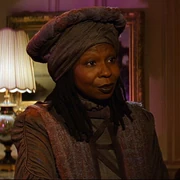
An "echo" of Guinan in the Nexus
With the appearance of Guinan, Picard is at first divided, tempted by the prospect of staying in the Nexus and living out this fantasy life. But he soon realizes that action must be taken and asks Guinan if he can leave the Nexus. Guinan tells him that the timeless nature of the Nexus would allow him go any place, any time. Picard knows exactly where he wants to go: the mountaintop on Veridian III to stop Soran from destroying the planet, but he will need help. As she already exists in the real world, Guinan tells the captain that she cannot go with him. But she says there is somebody who can help.

Kirk meets Picard
Suddenly Picard finds himself standing outside a rustic cabin in the woods, daylight shining down through the trees. A few feet away, James T. Kirk stands, chopping wood with an axe. Seeing Picard, Kirk smiles, "Beautiful day." Picard agrees and helps Kirk chop wood, asking "Do you know how you got here?" Kirk isn't quite sure; one second he was aboard the Enterprise-B, the next he was here, chopping wood. Before Picard can question the captain further, Kirk is drawn inside the cabin, hurrying into the kitchen where eggs burn on the stove. Kirk tells Picard to come on in, this is his house – at least, it used to be.
Picard steps inside and into the kitchen, helping Kirk prepare a fresh set of eggs on the stove. Picard hesitates momentarily, then introduces himself as Captain of the Enterprise, from what Kirk would consider the 24th century. Kirk is too distracted by the memories of the past to fully take what Picard says on board, excited to be in his old home, with his beloved dog Butler, who seemingly died years ago. A woman calls down to him and he instantly knows who it is: Antonia, a lost love. Quickly preparing breakfast, Kirk prepares to charge upstairs and rewrite his own history. Picard tries to stop him, telling the captain that as a Starfleet officer, he is obligated to return to Veridian III with him and stop Soran. Kirk feels the galaxy owes him one and marches up the stairs to Antonia.
Two captains. One breakfast.
Picard follows Kirk up the stairs and after a moment's hesitation, opens the bedroom door and walks into a barn on Earth. "This is not your bedroom," Picard half asks Kirk, who says that it is even better: his uncle's barn in Idaho. Grabbing a saddle, Kirk jumps onto a horse and gallops out into rolling hills. Picard watches him go, then grabs a saddle himself and rides after him. Ahead of Picard, Kirk and his horse come to a deep ravine. Without equivocation, Kirk jumps the ravine, then turns around and jumps it again, stopping to consider it. As Picard rides up, Kirk knows something is wrong: "I must have jumped that fifty times, scared the hell out of me each time. Except this time, because it isn't real. Nothing here is." He looks up and sees Antonia on the horizon, waiting. "She isn't real either." Kirk moves his horse next to Picard and gives the new Enterprise captain a once over. "Captain of the Enterprise, huh?"
The two men sit on horseback and discuss the situation. Kirk admits that he does not miss the house or the family he never had, he misses his days on the Enterprise when he made a difference. Picard appeals to Kirk, "Come back with me, make a difference again." Kirk considers it, then agrees, "Who am I to argue with the captain of the Enterprise?"
Kirk and Picard leave the Nexus
"I take it the odds are against us and the situation is grim," Kirk says. Picard admits that it is. Kirk continues, "You know, if Spock were here, he'd say that I'm an irrational, illogical human being for taking on a mission like that... sounds like fun."
Together, they ride off and a beam of light envelops them as they exit the Nexus and move into the past.

Soran fires his disruptor
Soran stands on the Veridian III mountaintop and checks his pocket watch when a figure steps toward him. Soran looks up at the man and scowls, "Just who the hell are you?" Behind him, Picard appears, "He's James T. Kirk. Don't you read history?" Soran knows he is in trouble and jumps away, down onto the rocks below and makes a quick retreat. Picard heads for the launcher as Kirk sets off in pursuit of the El-Aurian.
Rounding a corner, Kirk is caught by Soran who shoves a disruptor in his face. "Actually I am familiar with history," Soran growls, "and if I'm not too mistaken... you're dead!" Picard jumps down behind Soran, catching him off guard long enough for Kirk to get in several blows. Kirk and Soran fight, exchanging punches until Kirk is able to throw Soran off a cliff. Grabbing onto a dangling rope, Soran saves himself, entering a command into his PADD that cloaks his rocket launcher. Suddenly the rope snaps and Soran drops suddenly, then jolts to a stop, losing his control PADD which falls onto a metal bridge spanning a chasm.

Kirk and Picard work together to stop Soran
Realizing they must decloak the launcher to prevent it from launching, Kirk and Picard run onto the bridge toward the PADD. A volley of disruptor fire flies through the air, narrowly missing the two Starfleet captains and slicing the bridge in half. Picard is thrown clear, but Kirk hangs on to what is left of the bridge. With all his might, Picard pulls Kirk to safety and the two collapse on the ground, noticing the PADD intact on the other half of the bridge, a deep chasm away. Kirk volunteers to go, telling Picard to get to that launcher and prepare to deactivate it once it is decloaked.
Gingerly stepping out onto the broken bridge, Kirk stands at the edge, preparing to jump over the chasm to the other half. As the delicate bridge collapses under his weight, Kirk leaps, catching himself on the other half of the bridge and grabbing hold of the PADD. Entering in a command, Kirk decloaks the rocket launcher and begins to climb up. But it is too late. The bridge buckles and careens down the rock face, taking Kirk with it.

Soran's launcher explodes
Running up a platform and onto the launcher, Picard frantically works the controls, trying to prevent it from launching. Aiming his disruptor at Picard, Soran demands the captain step away from the launcher. Picard jumps down and runs around a rock face and out of sight. Soran heaves himself onto the launcher, just in time to read the display screen: the locking clamps are engaged. Soran has no time to react, the launcher fires and explodes in an enormous fireball that covers the entire area in a thick cloud of smoke and dust.

Captain Kirk dies
Emerging from the cloud, Picard makes his way down into the chasm where the bridge has collapsed. Digging through the twisted metal wreckage, Picard uncovers Kirk, laying broken among the debris. Kirk is bloody and faint, "Did we make a difference?" Picard assures him they have and thanks the captain. "The least I could do," Kirk says, "for the captain of the Enterprise." He manages a weak smile, "It was... fun," then turns and faces his destiny, "Oh my."
Burying Kirk on the mountaintop, Picard stands and keeps silent vigil.
A time later, he begins a long trek through the desert until an Enterprise shuttlecraft appears and picks him up.
- "Captain's log, stardate 48650.1. Three Starfleet vessels have arrived in orbit and have begun to beam up the Enterprise survivors. Our casualties were light, but unfortunately the Enterprise herself cannot be salvaged."
At the saucer crash site, Starfleet ships have begun a salvage effort. In the ship's broken cargo bay, Deanna Troi and Data use tricorders to search for survivors, detecting a faint lifeform in the wreckage. Tearing through the debris, Data finds his cat, Spot, alive and well. Overcome with emotion, Data begins to cry, cradling his pet in his arms.

"Somehow I doubt this will be the last ship to carry the name Enterprise."
In what is left of Picard's ready room, Commander Riker and Captain Picard retrieve the Picard family album and move out onto the bridge, a burnt-out shell of its former glory. Picard relates to his first officer his thoughts, "Someone once said that time was a predator that stalked us all our lives, but I rather believe that time is a companion that goes with us on the journey, and reminds us to cherish every moment because they'll never come again." They stand near the center seats and survey the damage. Picard holds his family album close and smiles, "What we leave behind is not as important as how we lived. After all, Number One, we're only mortal." Riker grins mischievously, "Speak for yourself, sir. I plan to live forever."
Riker is disappointed that he will no longer have the chance to command the Enterprise-D and stands near the ruined captain's chair. Picard nods, telling Riker that he doubts that the Enterprise-D will be the last ship to bear the name Enterprise. Picard and Riker take one last look around their destroyed starship and calls the Farragut for two to beam up.
Memorable Quotes
"Very good, sir."
"Brought a tear to me eye."
"Oh, be quiet."
- - Chekov and Scotty, good naturedly ragging on Kirk, and his simple order to take the Enterprise-B out of spacedock
"Finding retirement a little lonely, are we?"
"You know, I'm glad you're an engineer. With tact like that, you'd make a lousy psychiatrist."
- - Scotty and Kirk
"I was never that young."
"No. You were younger."
- - Chekov and Kirk after meeting Demora Sulu
"Captain, is there something wrong with your chair?"
- - Scotty after Kirk repeatedly stands up but says nothing
"Captain Kirk, I would appreciate any suggestions you might have."
"First, move us within transporter range and beam those people aboard the Enterprise."
"What about the gravimetric disturbances, they'll tear us apart."
"Risk is part of the game if you want to sit in that chair."
"Helm, close to transporter range."
"And second, turn that damned thing off!" (the reporter's camera)
- - Harriman and Kirk
"Load torpedo bay. Prepare to fire on my command."
"Captain, we don't have any torpedoes."
(Looks at Captain Harriman) "Don't tell me... Tuesday."
- - Kirk and Demora Sulu, on the Enterprise-B
"How big is your medical staff?"
"The medical staff... doesn't arrive 'til Tuesday."
(Chekov says "Amazing!" in Russian ("Удивительно"), then turns and points to two reporters) "You and you, you've just become nurses. Let's go."
- - Chekov and Captain Harriman
"Transport complete. I got 47... out of 150."
- - Scotty, completing the attempt to transport the survivors aboard the Lakul when it explodes
"I'll go, you have the bridge."
"Wait!" (Harriman stops at the turbolift)
"Your place is on the bridge of your ship. I'll take care of it."
(Harriman returns to the captain's chair and Kirk moves to the turbolift)
"Scotty, keep things together until I get back."
"I always do."
- - Harriman, Kirk and Scotty
"My God! Was anybody in here?"
"...Aye."
- - Chekov, about the missing part of the hull, Scotty, knowing Kirk was in the room
"We, the officers and crew of the USS Enterprise, being of sound mind, make the following charges against Lieutenant Worf. One: That he knowingly and willfully performed above and beyond the call of duty on countless occasions. Two, most seriously: That he has earned the respect and admiration of the entire crew."
"Mr. Worf, I hereby promote you to the rank of Lieutenant Commander, with all the rights thereto! And may God have mercy on your soul."
- - Riker and Picard, reading Worf's promotion orders
"Computer, remove the plank!"
(The plank disappears completely and Worf falls into the sea, much to the amusement of the crew (save for Worf). Picard leans over to Riker)
"Number One, that's retract the plank, not remove the plank..."
"Of course, sir." (Riker leans over the edge to look at Worf, who is angrily cursing and splashing in the water) "Sorry!"
- - Riker and Picard
"Just imagine what it was like. No engines, no computers. Just the wind and the sea and the stars to guide you."
"Bad food, brutal discipline... no women."
- - Picard and Riker
"Number One... will you begin an investigation? I'll be in my ready room."
"Sir, ..."
"Make it so."
"I thought..."
"Just do it!"
- - Picard and Riker
"Gentlemen, something new from Frocas III?"
(Data drinks and shudders)
"What is it, Data?"
"I believe this beverage has produced an emotional response."
"Really? What are you feeling?"
"I am uncertain. Because I have had little experience with emotion I am unable to... articulate the sensation."
"Emotion?"
"I'll explain later."
(Data takes another drink and shudders more violently.) "Ooh!"
"Well, it looks like he hates it."
"Yes, that is it. I hate this!" (...takes another drink) "Oh yes! I hate this! It is revolting!"
"More?"
"Please."
- - Guinan, Data and Geordi, during the meeting in Ten-Forward
"They say that time is the fire in which we burn."
- - Tolian Soran
"I get it!"
"You get what?"
"When you said to Commander Riker, 'The clown can stay, but the Ferengi in the gorilla suit has to go'!" (Data laughs loudly)
"What are you talking about?"
"During the Farpoint mission. We were on the bridge, you told the joke, that was the punchline."(Data laughs again)
"Farpoint? Data, that was seven years ago."
"I know. I just got it!"
- - Data and La Forge, when Data laughs at a joke that La Forge made at Farpoint Station in TNG: "Encounter at Farpoint"
"Make it so."
- - Data, imitating Picard with his tricorder
"Humor! I love it! Heee!"
- - Data
"Open sesame!"
- - Data while opening a door
"You could say... I have a magnetic personality."
- - Data
"I hope, for your sake, you were initiating a mating ritual."
- - B'Etor to Soran, after he punched her
"There was a time when I wouldn't hurt a fly. And then the Borg came..."
- - Tolian Soran
"Human females are so repulsive!"
- - B'Etor, watching La Forge's bug, as she looks right at Dr. Crusher
"I just love scanning for lifeforms. (commences singing and tapping on console like a keyboard) Lifeforms... you tiny little lifeforms... you precious little lifeforms... where are you?"
- - Data - Listen to this quote file info
"I don't know... he bathed... now he is roaming the ship. He must be the only engineer in Starfleet who does not go to engineering!"
- - B'Etor, about La Forge
"Yes! Mmf!"
- - Data, triumphantly cheering after the Klingon ship is destroyed
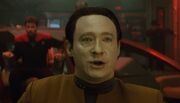
"Oh...shit!"
"Oh... shit!"
- - Data, as the saucer is crashing down on Veridian III
"Now, if you'll excuse me, captain. I have an appointment with eternity... and I don't want to be late."
- - Soran, to Picard, shortly before he enters the Nexus
"Captain of the Enterprise, right?"
"That's right."
"Close to retirement?"
"I'm not planning on it."
"Well, let me tell you something. Don't. Don't let them promote you. Don't let them transfer you, don't let them do anything that takes you off the bridge of that ship, because while you're there, you can make a difference."
"Come back with me. Help me stop Soran. Make a difference again."
"Who am I to argue with the captain of the Enterprise? What's the name of that planet, Veridian III?"
"Yes."
"I take it the odds are against us and the situation is grim."
"You could say that."
"You know, if Spock were here, he'd say I was an irrational, illogical human being for taking on a mission like that... sounds like fun."
- - Kirk and Picard
"Just who the hell are you?"
"He's James T. Kirk. Don't you read history?"
- - Soran and Picard, as Kirk reveals himself to Soran
"I thought you were heading for the launcher."
"I changed my mind. Captain's prerogative."
- - Kirk and Picard
"Did we do it? Did... we make a difference?"
"Oh yes, we made a difference. Thank you."
"Least I could do for the captain of the Enterprise. It was... fun. (beat) Oh, my."
- - Kirk and Picard, including Kirk's last words
(Data sniffles as he holds Spot.)
"Data? Are you all right?"
"I am uncertain, Councilor. I am happy to see Spot, yet I am crying. Perhaps the chip is malfunctioning."
(Deanna smiles.)"I think it's working perfectly."
- - Deanna and Data, after recovering Spot from the Enterprise wreckage
"I'm gonna miss this ship. She went before her time."
"Someone once told me that 'time' is a predator that stalks us all our lives. But I rather believe that time is a companion who goes with us on the journey and reminds us to cherish every moment because it will never come again. What we leave behind is not as important as how we've lived. After all Number One, we're only mortal."
"Speak for yourself, sir. I plan to live forever." (steps over to Picard's ruined captain's chair) "I always thought I'd get a shot at this chair someday."
"Perhaps you still will. Somehow I doubt this will be the last ship to carry the name Enterprise. (taps communicator) Picard to Farragut, two to beam up."
- - Picard and Riker's last moments aboard the Enterprise-D
"Mister Tricorder! Ha ha ha ha!!!!"
- - Data making a mouth with his tricorder
"What's 'normal'?"
"What's normal? Well, that's a very good question. Normal is what everyone else is and you are not."
- - Geordi and Soran
Background Information
Development
| Movie trailer |
Star Trek: The Next Generation executive producer Rick Berman was approached by Paramount Pictures executives in the winter of 1992 (during the series' sixth season) in regards to a seventh Star Trek film. While the studio intended Star Trek VII to be a TNG vehicle, Berman felt the outing was an opportunity to "pass the baton." In February 1993, Berman and the studio commissioned two stories and three writers. A fourth, TNG writer and Star Trek: Deep Space Nine co-creator Michael Piller passed. As written by former TNG writer/producer Maurice Hurley, the film followed William Shatner as James T. Kirk traveling through time to the 24th century. As proposed by then-current TNG writers Ronald D. Moore and Brannon Braga, the film would feature the entire Original Series cast in a prologue, with Captain Kirk later appearing at the film's climax. Berman later recalled the process:
- "In both scripts, the stories that we developed, were stories that entailed to different degrees members of The Original Series along with The Next Generation. First, we went through the story development on both, and both stories were submitted to the studio. We got a lot of notes from the studio, the stories were revised, and then we went to first draft on each. Eventually, it became quite obvious that the studio and I were leaning toward Ron's and Brannon's script. That's not to say Maury's script wasn't terrific, it just was far less advanced by the time we really had to make a decision."
Berman and the studio pursued the Moore/Braga story. A first draft script was completed during TNG's sixth season hiatus, dated 1 June 1993.
Initially bandying about ideas involving the two Enterprise crews battling each other, Moore and Braga quickly abandoned the concept. Ron Moore explained in 1994:
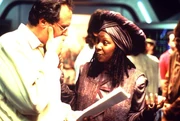
Rick Berman and Whoopi Goldberg discuss the script on set
- "...The best possible poster you could ever hope to have for this picture would show you the two Enterprises battling against each other. We all tried our best, but we were never able to come up with any scenario that made both crews look heroic. No matter how we played around with this thing, somebody was gonna come off looking like the bad guy. So then we returned, a little more solidly, to the "mystery that spans two generations" idea that would allow Whoopi Goldberg, as Guinan, as the tie that binds the two."
Searching for a major "event" to anchor the film:
- "...One of us just kinda threw out, 'What if we kill Kirk?' And we all kinda looked at each other and said, 'Wow. That would be amazing.' ...From that point on, Kirk's death became part of the fabric of our story, and as a big surprise to us all, there was never a moment where it really came into question."
Eventually paring the appearances of the TOS cast members down to two select cameos and the role of James T. Kirk bookending the film, the producers then sought their guest stars. While William Shatner agreed to appear pending script approval, Leonard Nimoy and DeForest Kelley – the two preferred cameo appearances – were less eager to return. Stating that they had felt their characters made sufficient exits in Star Trek VI: The Undiscovered Country, both actors declined to appear in Star Trek VII. Leonard Nimoy – having been offered the director's chair – reportedly requested script changes, but was rebuffed. In his memoir Star Trek Movie Memories, William Shatner wrote:
- "Leonard, surprisingly, wasn't all that upset with this unusual turn of events. As you know, on Treks III, IV and VI, Leonard had been very involved very early on, nursing his projects through the story level and the scripting process, while simultaneously functioning as director and ultimately producer. However, this time around, that simply wouldn't have been his job. This story came from Rick Berman. It was written by his own handpicked writers, and essentially, Leonard was being asked to shoot their script as written, and he wasn't all that interested."
In an interview with Trekmovie.com's Anthony Pascale in July 2007, Nimoy explained the issues he had with the Generations script and why he declined to appear. After proclaiming that "there was no Spock role in that script", he elaborated:
- "There were five or six lines attributed to Spock [...] but it had nothing to do with Spock. They were not Spock-like in any way. I said to Rick Berman, 'You could distribute these lines to any one of the other characters and it wouldn’t make any difference.' And that is exactly what he did. There was no Spock function in the script. I have always tried to make a contribution to these movies. There was no contribution to be made in that movie. It was just sort of 'let's get Nimoy in here too.' I said there is nothing here I can do so I said 'thanks, but I'll pass'." [1]
Early drafts of the script took shape under the guidance of Rick Berman and with input by Shatner. The film's villain, "Moresh", was later changed to Dr. "Soran" to avoid recalling David Koresh, the infamous cultist. The early scripts also featured large action set pieces that were later removed. Among them was the Romulan attack on the Amargosa observatory, cut when TNG writer (and Star Trek: Voyager co-creator) Jeri Taylor suggested something more "charming". Another major revision to the script revolved around the Duras sisters and their crew: surviving the destruction of their ship, they would have battled the Enterprise-D crew in the jungles of Veridian III.
Later drafts of Generations and the full TNG finale "All Good Things..." were written simultaneously. This often led the writers to mix the stories up. In their joint 2004 commentary for the Star Trek Generations (Special Edition) DVD, they admitted that they felt "All Good Things..." turned out to be the superior effort. During the scripting stages, however, the studio had few qualms and preproduction proceeded even as filming on Star Trek: The Next Generation was winding down and Deep Space Nine continued.
Preproduction
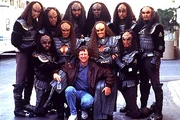
David Carson surrounded by Klingons, Barbara March, Gwynyth Walsh and Guy Vardaman
With the start of preproduction, Berman battled the studio over budget figures, the film cut in cost to an estimated US$35 million. [2] Hopes for location shooting in Hawaii and Idaho were dropped in favor of more local shoots in Hollywood, Marina del Rey, Pasadena, Lone Pine, and the Valley of Fire State Park near Las Vegas, Nevada. By 16 March 1994, Moore and Braga's script reflected budget and cast changes.
In place of first choice Leonard Nimoy, veteran TNG and DS9 director David Carson was hired, in turn recruiting veteran cinematographer John Alonzo of Chinatown and Scarface fame. Herman Zimmerman – who designed the initial TNG and DS9 sets – was called back into service on the film, working with Alonzo and illustrator John Eaves to refresh the aging TV sets. Budgetary constraints reined in some of the proposed sets; the new stellar cartography set reduced from three levels to two. As with most of the previous Trek movie installments, visual effects giant Industrial Light & Magic was hired to produce space and spaceship shots, while TNG mainstay CIS Hollywood was brought in for phaser shots, transporter effects, cloaking and decloaking transitions and the Picard family Christmas ornament.
Last minute decisions included the hiring of actor Malcolm McDowell as the man who would (as far as the final draft script) gun down Captain Kirk, reportedly later receiving death threats from obsessed fans. [3] The actor's nephew and DS9 star Alexander Siddig later said during an interview that McDowell thought the script was "shit". [4] McDowell had previously explained his reason for accepting the role:
- "When Rick asked me to be in this film, I was thrilled! I said, 'I'd LOVE to do it. I want to be THE man to kill Kirk.' And when I read the script I thought Soran was an interesting and wonderful character, and obviously he would ultimately be given the honor of pulling the trigger that kills the good Captain Kirk. I'd immediately become a trivia question at Star Trek conventions all over the globe."
Sets

Stellar cartography on screen and in real life
Despite its reuse of sets built, in some cases as early as 1979 for Star Trek: The Motion Picture, production designer Herman Zimmerman and his art department – namely John Eaves – began designing and redesigning as early as December 1993. One of the first and most elaborate sets generated from Paramount's motion picture art department was the two story stellar cartography room. Initially conceived of after a visit to Griffith Park's Laserium in Los Angeles, the room was imagined as a large sphere, eventually becoming a more budget-friendly cylinder. John Eaves described the process in his book, Star Trek: The Next Generation Sketchbook: The Movies:
- "[Illustrator] Clark Shaffer had just started on the film at this time, and he helped out with the immense load of drawings that had to be done. He took a rough console design I did for the cartography platform, and did a breakdown of the way the console should be put together. Again, I have to say that one of the exceptionally nice things about working on the Star Trek films is that everyone is so involved and helpful with design ideas. Mike [Okuda] and Herman [Zimmerman] contributed a number of wonderful ideas of how this room should look, and I have to say that the final set was an impressive thing to see (not only in the finished film, but in real life)."
While a hoped-for floating platform proved to be too expensive and impractical, the set was realized with a combination of large, back-lit graphics and blue-screen projection created at ILM. The set was created in sections with wild walls that could be moved in and out. Lighting elements were integrated into the ceiling requiring little modification from shot to shot. A small section of Enterprise-D corridor was erected behind the upper level platform.
Also conceived of in December, the Enterprise-B's deflector control room was designed to be a large, vertical area dominated by large machine elements, a second-level observation balcony and access panels built into the stage floor. Again, as the film's budget tightened, the design team returned to the drawing boards in February 1994 to design a smaller, vertical access shaft. David Carson recalled:
- "That gave us the most wonderfully interesting camera angles. Making the approach different, from horizontal to vertical, meant dealing with the budget in a creative way like that. Herman had a good time designing that; he ran through it about four times by himself just to make sure he had plenty of stuff for Shatner to do."
The bridge of the Enterprise-D as it appeared on television
The redressed and darker bridge
Regarding the most visible section of the Enterprise-D, the main bridge, Zimmerman and Eaves took the opportunity to alter the set. Echoing modifications it received in the TNG episode "Yesterday's Enterprise", the bridge gained additional computer stations situated along the port and starboard bulkheads. John Eaves:
- "Herman wanted to make the bridge more functional. To accomplish that, we raised the captain's chair slightly (symbolically putting his authority higher than those sitting in the two chairs flanking him). For functionality, we also split the ramps on either side of the commander center. We still had a ramp going down, but added two elevated stations, one against either wall, where crew members could work. We also replaced an alcove filled with lockers and storage panels with a new graphics station (courtesy of Mike Okuda). At one point, we had added some new stand-up stations behind the captain's chair, where Worf works. It was a nice design, but it wound up being simply too much of a modification, so we dropped it."
Worf, however, did finally receive a chair to sit on at his post. The set was also repainted and recarpeted with handrails added near the doors to the observation lounge and aft turbolift, working video monitors were incorporated into many of the ship's status displays. The captain's ready room, adjacent to the bridge, received a new, larger fish tank built into the wall and a larger window. Other sets aboard the Enterprise received only minor reworking. Engineering was connected to another corridor set by removing the "plugs" from the walls. The four red-alert lights in the hallway of the engineering set were also illuminated during the engineering scenes, even when the ship was not in battle. Overhead lighting was reduced in all of the sets, with display screens popping from the darkness. Of the modifications, Zimmerman said:
- "I hope the fans will say, 'Oh that's what I've been seeing on that little TV screen all these years'!"
Following the end of production, the interior sets of the Enterprise were struck and replaced with those belonging to a new starship, the USS Voyager, for the upcoming series Star Trek: Voyager. Of the original sets, only small sections of the corridors, sickbay, transporter room and engineering were left standing, although the new sets were constructed directly over the basic framework and floor plan originally designed and built for the aborted Star Trek: Phase II. Of those remaining sets, only a small piece of the Enterprise-D sickbay (the ceiling) remained in use during the most recent series Star Trek: Enterprise.
The interior of the Amargosa observatory was a redress of the Enterprise-B main bridge, which was itself a redress of the Enterprise-A main bridge from Star Trek VI. Details built into the observatory set were meant to imply that it had been built around the time of TOS, with jeweled buttons and labels similar to those used on the original Enterprise. A half-globe map of the cosmos used in the Enterprise-D stellar cartography lab on the TV series appears in the wreckage of the observatory, along with an elevator from Data's lab.
Costumes
His first task when recruited for the preproduction phase of Star Trek Generations, John Eaves created several new combadge designs, first creating a flip-top version like the communicators of TOS. Told to first review tapes of TNG to become more familiar with the new show, Eaves ultimately redesigned Rick Sternbach's oval-shaped communicator badge, refining it into the oblong-backed design later used in DS9, VOY and later TNG movies.
Costume designer Robert Blackman, working simultaneously on the outgoing, current and incoming series as well as the film, reworked Starfleet's uniforms. (AOL chat, 1997) The uniforms, however, were scrapped at the last minute for fear of introducing too many new facets to the universe. Unaware of the change, Playmates Toys went ahead with production of action figures for the film, depicting the TNG cast in the unused uniforms. The producers opted instead to use a combination of the costumes used throughout TNG and those introduced on DS9.
The new Starfleet uniform worn by Patrick Stewart was auctioned off in the It's A Wrap! sale and auction [5] along with LeVar Burton's [6]. Also auctioned off was Dr. Soran's costume upon arriving on the Enterprise-B. [7]
Effects
A digital Enterprise-D
Between the release of Star Trek VI: The Undiscovered Country and the preproduction phase of Star Trek Generations, several advancements had been made in the art of motion picture visual effects. Primarily spurred by steps forward in computer-generated animation in films like Jurassic Park, Generations marked the first Star Trek production in which many starships were rendered digitally by ILM. Despite this advancement, physical models were utilized for the majority of effects shots.
Unpacking the original nine-foot model they built for "Encounter at Farpoint" in 1987, the ILM effects team completely overhauled the Enterprise-D. In order to stand up to high resolution film cameras and big screen project, the starship was repainted and redetailed, receiving a new interior lighting scheme. Once again resulting from budgetary cuts, several stock footage shots of the Enterprise were interspersed with new model photography and CG imagery, notably during the captain's log segment and saucer separation sequence. Stock footage from the previous film was also used to depict the destruction of the Duras sisters' Bird-of-Prey, itself recycled from the previous four film outings.
Also reusing the original USS Excelsior miniature from Star Trek III: The Search for Spock, ILM and John Eaves were tasked with redesigning the ship to be used as the Enterprise-B:
- "First I took a photo that showed the Excelsior in spacedock, did a rendering, and started putting add-ons on the ship. When I met with Mike [Okuda], he pointed out that we needed to design an area that protruded from the ship, so that the energy ribbon could whip out a section while leaving most of the ship intact. So we built a section of decks extended out from the main body, which tapers gently on the bottom and flares out dramatically on the stop. We also did a detail sketch of the area around the deflector dish, designating one area as the reactor room. The addition of the decks gave the B's belly section a look similar to that of a P.B.Y. Catalina (a flying boat of the 1940s). The added girth increased the overall size of the vessel, while still retaining the original Excelsior design. We made a few other changes, such as taking two fins off the top of the saucer, and putting in two major impulse engines (we figured these stronger engines would be needed when the saucer detached). As for the nacelles, we added a cap to them, plus a dorsal fin on top and a running fin on the outer edge."
A computer-generated model of the Enterprise-B was also created for scenes that required it to interact with the digital Nexus energy ribbon.
An all-new miniature was created by ILM, designed by John Eaves, to represent the Amargosa stellar observatory. The model was later reused with minor alterations in DS9's "Destiny" as the wormhole relay station. The Enterprise-B model also turned up on that series as the USS Lakota. (DS9: "Paradise Lost") Yet another refurbished model appeared as the drydock the Enterprise-B was moored in, repainted and reconstructed from its first appearance in Star Trek: The Motion Picture.
Arguably one of the film's most memorable sequences, the crash of the Enterprise-D was shot almost entirely live by ILM. Storyboarded by Mark Moore, the shots were achieved through the creation of a twelve-foot model of the Enterprise-D saucer section and a large landscape model. Suspended by large cables, the saucer model was repeatedly flown into the landscape, shot with high speed cameras and then slowed down in post production and mixed with several composite shots of Veridian III. A major sequence in the script, the crash of the Enterprise saucer section was inspired by drawings of an emergency saucer landing in the Star Trek: The Next Generation Technical Manual.
Following the crash, effects master John Knoll and his team donned Starfleet uniforms to appear as crew members of the Enterprise-D, standing on a large blue tarp draped over the ILM parking lot. Footage of the team was later integrated into shots of the Enterprise hulk and the Veridian landscape.
Production
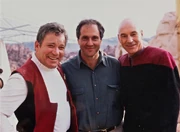
William Shatner, Rick Berman and Patrick Stewart at the Valley of Fire location
With production on TNG's final season still underway, cameras rolled on Generations and scenes focusing on Scotty, Chekov and Kirk aboard the USS Enterprise-B and the later deleted orbital skydiving sequence. A ten day hiatus followed the conclusion of production on The Next Generation before that series' cast went to work. Shot on a relatively short schedule, the film was slated for only 50 days of production.
For location filming in the Valley of Fire, director David Carson's production offices temporarily moved to a Las Vegas hotel. Suffering through the 110-degree heat and dust storms of the Nevada desert, the behind-the-scenes crew quenched their thirst with Gatorade until the sports drink began attracting bees. Carson was forced to wear an eye patch for at least one day of filming when his cornea was damaged during a surprise sand storm. More comfortable filming days were spent in Pasadena at the Nexus fantasy Picard home, a week aboard the Lady Washington for Worf's promotion in Marina del Rey and in the mountains of Lone Pine for Kirk's cabin - a real residence that acquired a new kitchen and staircase built specifically for the shoot. (citation needed • edit)
Reshoots

The original death of Captain Kirk: Soran shoots him in the back
Completing principal photography in the summer of 1994, rough cuts of Star Trek Generations were screened for test audiences. Despite generally favorable reactions to the bulk of the film, audience comments reflected negatively on the film's finale. In their joint DVD audio commentary, Ronald D. Moore and Brannon Braga recalled a feeling of disconnect washing over the audience, "We'd lost them."
Returning to the motion picture head Sherry Lansing's office on the Paramount Lot, Rick Berman, Moore and Braga were told, "You have a great movie, but a bad ending." The production was given a budget of US$5 million and told to reshoot the ending, specifically scenes in which James T. Kirk is shot in the back by Soran. Forced to utilize the same location, the writers struggled to insert a brand new finale into the framework already established. In late September 1994, the production crew and cast of Generations returned to the Valley of Fire and James T. Kirk was killed all over again. Having recently shaved his head for another project, Patrick Stewart wore a specially fashioned hairpiece during these scenes. Additional shots at the Pasadena "Picard family home" location were also required to clarify plot elements. Ronald D. Moore commented:
- "By the time of the test screening, we knew that this sequence wasn't working – we'd already seen dailies, of course, and had watched several rough cuts of the picture and everyone knew this wasn't playing the way we thought it would.
- Hope springs eternal, however, and we all went into the test screening with the hope that maybe we were over-thinking the problem or maybe we were too close to the film to really be objective at that point. Unfortunately, the test audience reaction pretty much confirmed what we all suspected. We were disappointed that our original vision didn't work, but we were grateful that the studio was willing to give us the time and money to go back and fix it. The executives believed in the picture and said basically, "You've got a good movie here, but you need to fix the ending." So Brannon, Rick, and I put our heads together and struggled to come up with a workable way to reshoot the death of Kirk and then to tweak the Christmas sequence and make it a little more coherent and meaningful. It was a very difficult task because of the time, money, and set constraints.
- Brannon and I talked over many, many different sequence involving various weapons, devices, hidden underground laboratories that Soran may have hidden under the mountain, phaser fights, cat and mouse chases, etc. but ultimately they all proved impractical, uninteresting, prohibitively expensive, or all of the above. The bridge gag came to us as we watched the footage over and over and realized that we might be able to use the established set pieces to our advantage. The studio, the director and the actors all liked the new version and so that's what we went with." (AOL chat, 1997)
Deleted Scenes

Picard and La Forge board the shuttlecraft Hawking in a deleted scene
Along with the original ending, several minutes of footage were left on the cutting room floor. Some of this footage is available on the Star Trek Generations (Special Edition) DVD. Most of the deleted scenes were minor character moments set following the crash of the Enterprise-D. Among the deleted material were sequences involving Dr. Crusher and Nurse Ogawa returning to sickbay, Geordi La Forge and Worf piloting a damaged shuttlecraft to rescue the captain, additional footage aboard the Enterprise sailing ship and an alternative version of the Nexus Christmas segment.
Scripted and shot at the request of William Shatner, the film's original opening featuring Kirk skydiving from orbit to find Scotty and Chekov waiting on the ground below was also cut, replaced with the champagne bottle opening.
The original script also called for a more extensive torture scene between Soran and La Forge, involving Soran injecting nanoprobes into La Forge's chest which caused extreme pain equivalent to a major heart attack. While this scene did not appear in the movie, Soran's comment of "his heart just wasn't in it" references the torture as does Doctor Crusher's medical examination where she discusses that she has "removed the nanoprobes" and that La Forge has suffered some myocardial damage.
Official Site
The official website for Star Trek Generations, created on 28 October 1994, was the first site on the internet to officially publicize a feature film. After being personally approved by then-Paramount Motion Picture chairman Sherry Lansing, the site was constructed by a team at Paramount Media Kitchen in Palo Alto, California, using press kit materials, videotapes of the film's trailer, and two-dozen slides. The site was an immediate success and prompted Paramount and other motion picture studios to create sites for their own films. [8]
Two versions of the official site were available for view, a graphics-rich version and a text-only version. Upon entering either version, the viewer was taken to a brief synopsis of the film followed by a greeting and an explanation of the site. From there, the viewer could watch the two movie trailers, view production stills, and listen to clips and music from the film. A behind-the-scenes page included sections on the history of Star Trek, cast and crew biographies, production notes, film credits, and a downloadable interactive multimedia kit. In addition, there was a Star Trek shop promoting Star Trek merchandise and an input page where viewers could send comments via forms or e-mail.
The site was a collaborative production of Paramount Pictures, Viacom Consumer Products, and Viacom Interactive Services. The site credits are as follows:
- Executive Producer
- Leonard Washington
- Art Director
- David Pettigrew
- Technology Director
- Paul Resch
- Internet Consultant
- Seth Skolnik
- Technical Producer
- Randy Taylor
- Online Producer
- Marc Wade
- Technical Support
- Dwight Bufford, Keith Gibbons, Stefan Lisowski
- Production Assistant
- Stephanie Wilson
The site was last updated on 23 November 1994. It has since been removed and a section at StarTrek.com has become the film's official web destination, found here. However, the original site, with commentary, can be accessed via a link in this StarTrek.com article.
Reaction
The release of Star Trek Generations was widely covered in the news media, Patrick Stewart and William Shatner appearing in character on the cover of Time Magazine in the winter of 1994. On its opening weekend, the film reached number one at the box office with a first weekend gross of US$23,100,000. [9] Critical reception, however, was mixed.
Earning a split decision from Siskel & Ebert, Gene Siskel gave the film thumbs up, Roger Ebert gave it thumbs down. Writing for the Chicago Sun Times, Ebert said of the film, "The "Star Trek" saga has always had a weakness for getting distracted by itself, and "Star Trek Generations," the seventh film installment, is undone by its narcissism." Giving the film two stars out of a possible four, Ebert concluded:
- "Star Trek seems to cross the props of science fiction with the ideas of Westerns. Watching the fate of millions being settled by an old-fashioned fistfight on a rickety steel bridge (intercut with closeups of the bolts popping loose and the structure sagging ominously), I was almost amused by the shabby storytelling. Why doesn't more movie science fiction have the originality and imagination of its print origins? In Stargate, the alien god Ra was able to travel the universe, yet still needed slaves to build his pyramids. In Star Trek Generations, the starship can go boldly where no one has gone before, but the screenwriters can only do vice versa." [10]
The film review website Rotten Tomatoes calculated a 47% overall approval rate for Generations. [11] BBC reviewer Tom Coates ranked the film at two out of a possible five stars, "Generations feels like three lacklustre episodes of the TV series mashed together with one of the earlier Star Trek movies. Devotees may find it necessary (if depressing) viewing, but there's little here for anyone else." [12] FILM.COM's Lucy Mohl however said of the film, "The meeting of Patrick Stewart's Jean-Luc Picard and William Shatner's James T. Kirk is worth the price of admission or video rental: it's the clash of the titans, Shakespeare meets the Sixties." [13]
Regarding some of the oft-mentioned plot discrepancies within the film, Ronald D. Moore commented:
- "Our reasoning (and it's admittedly thin) is that Picard didn't want to go back any further in time than absolutely necessary since he knows the extreme dangers of unexpected results from any tampering with the timeline. Okay, it's not much, but there it is." (AOL chat, 1997)
Moore and Braga further elaborated on this during the film's DVD commentary, saying that the question kept coming up and they even asked themselves, "Why would they go back to a point when their life would be in danger? Why not just go back a couple of months or so, find Soran in the bathroom or somewhere and take him out?" They also said that questions like that apply to films like The Terminator and you have to just hope that your film is compelling enough that the audience does not start asking questions like that.
The film went on to gross a total of US$75,668,868 in the US, totaling US$120,000,000 worldwide. [14]
The film was nominated for the Hugo Award for "Best Dramatic Presentation". Dennis McCarthy also won the ASCAP Award in the "Top Box Office Films" category.
Notes
Cast Trivia
- The only people, aside from the regular cast, to participate in both this film and the final TNG film, Star Trek Nemesis, are Majel Barrett and Whoopi Goldberg. In both films Barrett voiced the Enterprise computer and Goldberg appeared as Guinan.
- This is William Shatner's only appearance as Kirk without Leonard Nimoy.
- Though the film marks the final appearances of William Shatner and Walter Koenig (Chekov), both appeared again in the computer game Star Trek: Starfleet Academy.
- This is James Doohan's last appearance as Scotty, although he had previously appeared in the role in TNG: "Relics". The events of that episode succeeded the events of Generations Act One.
- Uhura is the only major character from The Original Series not to appear or be referenced in dialog.
- Tim Russ appeared aboard the Enterprise-B in the opening of the film. He had previously appeared in the episodes "Starship Mine" and "Invasive Procedures" as different characters and would soon after be cast as Tuvok in Star Trek: Voyager.
- Robert and René Picard were portrayed by different actors in the photographs in Picard's album, and in the Nexus scene as in the episode "Family".
- Christopher James Miller plays the film version of René, Captain Picard's nephew. He had previously portrayed William Shatner's son in an episode of seaQuest DSV.
- According to The Internet Movie Database (IMDb), Patrick Stewart was aided in his portrayal of Picard's grief by the script for Jeffrey, which he was reading on set.
- Shots of Picard standing over Kirk's grave did not actually feature Patrick Stewart, but rather Dennis Tracy. Tracy acted as Stewart's stand-in and appeared earlier in the film as an unnamed Bolian waiter in Ten Forward.
- Although Data is the owner of Spot the cat, Brent Spiner actually hates cats and objected to the scene where Data finds Spot in the wreckage of the Enterprise, saying "Does he have to find the cat? Can't he find, like, Geordi or something?"
- The captain of the Lady Washington (the ship used for the sea vessel "Enterprise") appears during the holodeck sequence of the film, taking over the helm from Deanna Troi.
- Generations marks the deaths of several major characters: Captain James T. Kirk, Robert Picard, René Picard, and the Duras sisters, Lursa and B'Etor. It also marks the destruction of the Enterprise-D and the final appearance of La Forge's VISOR.
- After the release of Generations, William Shatner and Leonard Nimoy made a joint appearance on Live with Regis and Kathie Lee. Host Regis Philbin asked Nimoy if he would appear in another Trek film to which he replied "if he [Shatner] shows up, I'll be there." Shatner then quipped: "You are such a liar! I showed up and you didn't!" Ironically, Nimoy later appeared in the 2009 film Star Trek without Shatner.
- Of the two Duras sisters, only Lursa's name is ever mentioned within the context of the movie. B'Etor's name is never spoken. The only time her character is actually identified is in the closing credits.
- Malcolm McDowell (Tolian Soran) is the real life uncle of Alexander Siddig, who played Julian Bashir throughout Star Trek: Deep Space Nine.
References to other series and films
- Footage of the interior of the Bird-of-Prey being destroyed appeared again later in the DS9 episodes "Tears of the Prophets" and "What You Leave Behind".
- Though not heard on screen, the name of the Lakul's counterpart was the SS Robert Fox, named for Ambassador Robert Fox from TOS: "A Taste of Armageddon".
- The scene in which Picard buries Kirk's body on a cliffside under rocks is reminiscent of Kirk burying Gary Mitchell in the second TOS pilot "Where No Man Has Gone Before".
- After Data's emotion chip is installed, he references a joke La Forge told during "Encounter at Farpoint", the pilot episode of Star Trek: The Next Generation. The punchline of the joke had to do with a "Ferengi in a gorilla suit." The Farpoint mission took place on stardate 41153.7, before official first contact with the Ferengi, however their existence was known. The joke was not seen in the actual episode.
- Doctor Soran ridicules Geordi's VISOR, predicting (and perhaps motivating Geordi to accept) the cybernetic eyes he gets in Star Trek: First Contact.
- The dress worn by Antonia was previously worn by Fenna and would later be reused on Leosa.
- No reference is made to the fact that, when last we saw the Duras sisters, Lursa was pregnant. Although enough time has passed to assume, given her lack of apparent pregnancy, that she had given birth by such time, the fate of her son is never revealed.
- In this film Kirk was saving the galaxy while Picard's grandfather was in diapers. This is a reference to "Relics", where Scotty was driving starships while La Forge's great-grandfather was in diapers.
Sets and props
- A bottle of Saurian brandy can be seen in the reception room at the christening of the Enterprise-B.
- Captain Picard's chair was stolen from the set mere hours before shooting was scheduled to commence. A new one was quickly fabricated.
- Data's emotion chip has varied in shape and size since its last appearance in TNG: "Descent, Part II" (which, in turn, was different from its previous appearance in TNG: "Brothers"). Also, Geordi inserts the chip into Data's head, while in "Brothers", Dr. Soong implanted the chip in Lore's (who he thought was Data) neck. The piece itself seen in this movie was a gold-plated plastic weapon common in the Zoids model kit line from Japan and America. (citation needed • edit)
- Among the items visible in Captain Kirk's house are a painting of the original Federation starship Enterprise, the ship's dedication plaque, a publicity photo of the cast of Star Trek VI: The Undiscovered Country, a Klingon bat'leth, a Starfleet phaser from Star Trek II: The Wrath of Khan, and a Jem'Hadar weapon from Star Trek: Deep Space Nine.
- While searching through the wreckage of the Enterprise-D's bridge, Picard happens upon the top half of the Kurlan naiskos originally seen in TNG: "The Chase" and places it back on the floor.
- A box of video tapes, which includes the graphic displays such as RADAR and subspace scan from the Enterprise-B's red alert sequence, was sold off on the It's A Wrap! sale and auction on eBay. [15]
Apocrypha
- Coinciding with the film's marketing campaign, a hardcover novelization was released by Pocket Books. Written by frequent Star Trek fiction contributor J.M. Dillard, the novelization differed from the movie on a number of minor points, but was generally faithful to the structure and dialogue of the original screenplay. The reshoot of the climactic Kirk scenes meant that the hardcover, and the Simon & Schuster Audioworks adaptation, had already gone to press with the originally scripted version. Dillard was asked to rewrite the final chapters for the eventual paperback release of the novelization to agree with the theatrical version of the movie.
- In the novel all other members of the original cast are part of the story. Chekov contacts Sulu aboard Excelsior to tell him about Kirk. In their conversation, Chekov tells Sulu that Scotty is contacting Uhura and Kirk's nephew. McCoy and Spock are also seen arriving early to the memorial service for Kirk.
- Also in the novelization, but missing from the film, a scene between Chekov and Guinan occurs in which she tells him that his friend is still alive within the energy ribbon.
- In the novelization, Picard successfully defeats Soran hand-to-hand; however, by the time he defeats him the rocket takes off to plunge into the sun. The movie depicts Soran as being a better fighter than Picard.
- In the original ending of the film, the fight between Kirk and Soran is much longer and they are much more evenly matched in terms of fighting skills. In the original ending, it's Kirk who's knocked off the cliff and is forced to climb back up the mountain to stop Soran.
- Other spin-offs from Pocket, which took their lead from plot elements in this movie, included William Shatner's The Ashes of Eden and The Return - picking up at the crashed saucer on Veridian III, and Engines of Destiny by Gene DeWeese, telling of Scotty's guilt after the apparent loss of Kirk. Following the events of "Relics", Scott travels back in time to rescue Kirk. However, this change in the timeline allows the Borg to almost completely overtake the Alpha Quadrant, as, without Kirk's aid, Picard died during the confrontation with Soran. Consequently, Earth is conquered by the Borg during the time-travel events of Star Trek: First Contact. Aided by the Enterprise-D crew, as well as alternate versions of Guinan and Sarek, Scott is forced to return Kirk to the Nexus, restoring the original timeline at the moment the Enterprise is destroyed by a Borg fleet.
- In the novel The Return, the Romulans and Borg went back in time and copied Kirk's brain waves before he died. They later stole his buried body, inserting the brain waves and using some Borg modifications to re-animate his body, turning him into a killing machine to hunt down Picard.
- According to Star Trek Online, the unseen child of Lursa has been born by the events of the film, that his name is Ja'rod and he survives to become an influential soldier of the Empire.
Merchandise gallery
Appendices
Credits
- All credits
- Uncredited Co-Stars
- David Keith Anderson as Ensign Armstrong
- Joe Bauman as Garvey
- Pam Blackwell as an El-Aurian
- Steven Boz as a security ensign
- Carl David Burks as an Enterprise-B crewman
- Cameron as Ensign Kellogg
- Victoria Cameron as Ten Forward waitress #1
- Tracee Lee Cocco as Lieutenant jg Jae
- Tarik Ergin as a Medical technician
- Whoopi Goldberg as Guinan
- Grace as a female alien civilian in Ten Forward
- Darrell Hall as the Enterprise Topman
- Kerry Hoyt as a security ensign
- Penny Juday as a Woman in Ten Forward
- Dale Kasman as a female Enterprise-B visiting admiral
- Bill Larson as the Enterprise navigator
- Stewart Lew as a crewman in Ten Forward
- M. McCahill as an Enterprise-B launch observer [16]
- Mary Meinel-Newport as a Bolian woman
- Lorine Mendell as an Enterprise-B crewman
- Judie Pimitera as Ten Forward waitress #2
- Jerry Quinn as an Enterprise-B crewman
- Keith Rayve as a command division crewman
- Raul Reformina as a command division crewman
- Richard Sarstedt as a command division crewman
- John Tampoya as an Enterprise-B crewman
- Dennis Tracy as a Bolian waiter
- Guy Vardaman as
- Terryl Whitlach as a civilian during saucer section crash
- Unknown actor as a Romulan corpse
- Uncredited stunts performers
- Jane Austin as stunt double for Gates McFadden
- Joni Avery as stunt double for Marina Sirtis
- Jay Caputo as an Enterprise-D Operations Division bridge crewman
- Eugene Collier
- Chris Durand as an Enterprise-D bridge crewman
- Norman Kent as stunt double for William Shatner (deleted sky diving scene)
- Rusty McClennon as stunt double for Michael Dorn
- Jeff Mosley as stunt double for Michael Dorn
- Denney Pierce as an Enterprise-D helm crewman
- Mark Riccardi as the stunt double for Jonathan Frakes
- Pat Romano - stunt rigger
- Lynn Salvatori as Antonia
- David Wendler as stunt double for William Shatner (horse jump)
- Brian J. Williams as stunt double for Brent Spiner
- Merritt Yohnka
- Uncredited stand-ins
- David Keith Anderson
- Stand-in for LeVar Burton
- Stand-in for Tim Russ
- Margaret Flores - stand-in for Marina Sirtis
- Nora Leonhardt - stand-in for Marina Sirtis
- Lorine Mendell - stand-in for Gates McFadden
- James Minor - stand-in for Michael Dorn
- Kevin Reed O'Hara - photo double for Walter Koenig
- Keith Rayve - stand-in for Brent Spiner
- Richard Sarstedt - stand-in for Jonathan Frakes
- Dennis Tracy - stand-in for Patrick Stewart
- Guy Vardaman - body double for Brent Spiner
- Philip Weyland - stand-in for William Shatner
- Uncredited production staff
- Tom Bookout - Grip
- Bernie Dresel - Orchestra Drummer
- Christopher Flick - Foley Editor
- Edward J. Franklin - Special Effects Artist
- Bill Hawk - Prop fabricator
References
Academy marathon; alternate timeline; Amargosa; Amargosa observatory; Amargosa system; antimatter containment; bat'leth; Battle of Trafalgar; Bolian; Borg; Bozeman, USS; Breen; Butler; champagne; Chateau Picard; Christmas; cloaking device; communications station; crew quarters; Crusher, Beverly; dedication plaque; deflector control; deflector dish; diaper; dill weed; disruptor; Dom Pérignon; drydock; Du'cha; duotronics; Earth; Earth Broadcasting Company (EBC); El-Aurian; emotion chip; USS Enterprise; Enterprise, USS; Enterprise-A, USS; Enterprise-B, USS; Enterprise-D, USS; Template:ShipClass; Farpoint Mission; Farpoint Station; Farragut, USS; Farragut shuttlecraft; Farrell; Federation News Network (FNN); Forcas III; force field; Template:ShipClass; gravimetric distortion; gravimetric field; Hawking; holodeck; horseback riding; House of Duras; Idaho; Kirk, James (Jim) Klingons; Klingon Bird-of-Prey; Ktarian eggs; Kurlan naiskos; La Barre; Grankite Order of Tactics; ionic pulse; Lakul, SS; Livingston; magnetic interlock; maiden voyage; main engineering; Martian colonies; Maurice Picard; McCoy, Leonard; Template:ShipClass; Template:ShipClass; Nexus; oregano; Nobel Prize; Template:ShipClass; photon torpedo; Picard family album; Picard, Robert; plasma coil; plasma coolant; Pluto; pocket watch; RADAR; Robert Fox, SS; Romulans; San Francisco; Saratoga, USS; Saurian brandy; saucer section; saucer separation; science station; shield frequency; Spacedock Shuttle; sickbay; Spock; Spot; Starfleet Broadcasting (SFB); Stargazer, USS; Starfleet Academy; Starfleet uniform; Stellar Cartography; subspace scan; Sulu, Hikaru; temporal energy; Ten Forward; tricorder; trilithium; trilithium weapon; type-3 disruptor; type-6 shuttlecraft; type-7 shuttlecraft; Veridian; Veridian system; Veridian III; Veridian IV; VISOR; Wallace, Darian; warp core breach; warp plasma; Workbee
Media
- Star Trek Generations (Special Edition DVD)
- Star Trek Generations (DVD)
- Star Trek Generations (soundtrack)
- Star Trek Generations (novel)
- Star Trek Generations (game)
Sources
- Star Trek: The Next Generation Companion, Larry Nemecek, Pocket Books, 2002.
- Star Trek: The Next Generation Sketchbook: The Movies, John Eaves & J.M. Dillard, Pocket Books, 1998.
- Star Trek: The Next Generation - The Continuing Mission, Judith & Garfield Reeves-Stevens, Pocket Books, 1998.
- Star Trek Movie Memories, William Shatner & Chris Krenski, Pocket Books, 1994.
- Star Trek Generations (Special Edition) DVD, Ronald D. Moore & Brannon Braga, audio commentary.
- Star Trek Generations (Special Edition) DVD, Michael & Denise Okuda, text commentary.
External links
- Star Trek Generations at Wikipedia
- Template:IMDb-link
- Behind the scenes on Star Trek: Generations at Forgotten Trek - features production history, concept art, and set design
| Previous movie: Star Trek VI: The Undiscovered Country |
Star Trek Movies | Next movie: Star Trek: First Contact |

